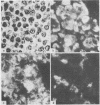Abstract
A panel of seven monoclonal antibodies has been used to characterise 164 cerebral and spinal tumours. These reagents have enabled rapid and accurate diagnosis of tumours to be made, particularly in cases where standard techniques have proved equivocal. On the basis of characteristic antigenic profiles of tumours, it has been possible to distinguish between gliomas, meningiomas, schwannomas, medulloblastomas, neuroblastomas, choroid plexus tumours, various metastatic deposits, and primary brain lymphomas. The reagents used in the study comprise antibodies binding to (a) most neuroectodermally derived tissues and tumours (UJ13A), (b) fetal brain and tumours of neuroblastic origin (UJ181.4), (c) schwannomas, normal and neoplastic neurones (UJ127.11), (d) glial cells (FD19), (e) epithelial cells (LE61), and (f) leucocytes (2D1). Some reagents, such as antibody A2B5, were less effective as diagnostic markers than originally suggested by previously described specificity. This monoclonal antibody reacted with both neuroectodermal and epithelial derived tumours. The panel of monoclonal antibodies was most useful in the diagnosis of tumours composed of small round cells, particularly lymphoma and neuroblastoma, but the pattern of reactivities allowed most of the central nervous system tumours to be accurately classified. This approach was a valuable adjunct to conventional histological techniques in about 20% of the cases examined.
Full text
PDF








Images in this article
Selected References
These references are in PubMed. This may not be the complete list of references from this article.
- Allan P. M., Garson J. A., Harper E. I., Asser U., Coakham H. B., Brownell B., Kemshead J. T. Biological characterization and clinical applications of a monoclonal antibody recognizing an antigen restricted to neuroectodermal tissues. Int J Cancer. 1983 May 15;31(5):591–598. doi: 10.1002/ijc.2910310510. [DOI] [PubMed] [Google Scholar]
- Arklie J., Taylor-Papadimitrious J., Bodmer W., Egan M., Millis R. Differentiation antigens expressed by epithelial cells in the lactating breast are also detectable in breast cancers. Int J Cancer. 1981 Jul 15;28(1):23–29. doi: 10.1002/ijc.2910280105. [DOI] [PubMed] [Google Scholar]
- Bignami A., Eng L. F., Dahl D., Uyeda C. T. Localization of the glial fibrillary acidic protein in astrocytes by immunofluorescence. Brain Res. 1972 Aug 25;43(2):429–435. doi: 10.1016/0006-8993(72)90398-8. [DOI] [PubMed] [Google Scholar]
- Camins M. B., Cravioto H. M., Epstein F., Ransohoff J. Medulloblastoma: an ultrastructural study--evidence for astrocytic and neuronal differentiation. Neurosurgery. 1980 Apr;6(4):398–411. [PubMed] [Google Scholar]
- Coakham H. B., Garson J. A., Brownell B., Allan P. M., Harper E. I., Lane E. B., Kemshead J. T. Use of monoclonal antibody panel to identify malignant cells in cerebrospinal fluid. Lancet. 1984 May 19;1(8386):1095–1098. doi: 10.1016/s0140-6736(84)92508-x. [DOI] [PubMed] [Google Scholar]
- Eisenbarth G. S., Walsh F. S., Nirenberg M. Monoclonal antibody to a plasma membrane antigen of neurons. Proc Natl Acad Sci U S A. 1979 Oct;76(10):4913–4917. doi: 10.1073/pnas.76.10.4913. [DOI] [PMC free article] [PubMed] [Google Scholar]
- Garson J. A., Beverley P. C., Coakham H. B., Harper E. I. Monoclonal antibodies against human T lymphocytes label Purkinje neurones of many species. Nature. 1982 Jul 22;298(5872):375–377. doi: 10.1038/298375a0. [DOI] [PubMed] [Google Scholar]
- Gatter K. C., Abdulaziz Z., Beverley P., Corvalan J. R., Ford C., Lane E. B., Mota M., Nash J. R., Pulford K., Stein H. Use of monoclonal antibodies for the histopathological diagnosis of human malignancy. J Clin Pathol. 1982 Nov;35(11):1253–1267. doi: 10.1136/jcp.35.11.1253. [DOI] [PMC free article] [PubMed] [Google Scholar]
- Ghadially F. N. The role of electron microscopy in the determination of tumour histogenesis. Diagn Histopathol. 1981 Jul-Sep;4(3):245–262. [PubMed] [Google Scholar]
- Kemshead J. T., Fritschy J., Garson J. A., Allan P., Coakham H., Brown S., Asser U. Monoclonal antibody UJ 127:11 detects a 220,000-240,000 kdal. glycoprotein present on a sub-set of neuroectodermally derived cells. Int J Cancer. 1983 Feb 15;31(2):187–195. doi: 10.1002/ijc.2910310209. [DOI] [PubMed] [Google Scholar]
- Kemshead J. T., Jones D. H., Goldman A., Richardson R. B., Coakham H. B. Is there a role for radioimmunolocalization in diagnosis of intracranial malignancies?: discussion paper. J R Soc Med. 1984 Oct;77(10):847–854. doi: 10.1177/014107688407701010. [DOI] [PMC free article] [PubMed] [Google Scholar]
- Köhler G., Milstein C. Continuous cultures of fused cells secreting antibody of predefined specificity. Nature. 1975 Aug 7;256(5517):495–497. doi: 10.1038/256495a0. [DOI] [PubMed] [Google Scholar]
- Lane E. B. Monoclonal antibodies provide specific intramolecular markers for the study of epithelial tonofilament organization. J Cell Biol. 1982 Mar;92(3):665–673. doi: 10.1083/jcb.92.3.665. [DOI] [PMC free article] [PubMed] [Google Scholar]
- Makin C. A., Bobrow L. G., Bodmer W. F. Monoclonal antibody to cytokeratin for use in routine histopathology. J Clin Pathol. 1984 Sep;37(9):975–983. doi: 10.1136/jcp.37.9.975. [DOI] [PMC free article] [PubMed] [Google Scholar]
- Trojanowski J. Q., Lee V. M. Monoclonal and polyclonal antibodies against neural antigens: diagnostic applications for studies of central and peripheral nervous system tumors. Hum Pathol. 1983 Apr;14(4):281–285. doi: 10.1016/s0046-8177(83)80111-7. [DOI] [PubMed] [Google Scholar]
- Velasco M. E., Dahl D., Roessmann U., Gambetti P. Immunohistochemical localization of glial fibrillary acidic protein in human glial neoplasms. Cancer. 1980 Feb;45(3):484–494. doi: 10.1002/1097-0142(19800201)45:3<484::aid-cncr2820450312>3.0.co;2-9. [DOI] [PubMed] [Google Scholar]
- Warnke R. A., Gatter K. C., Falini B., Hildreth P., Woolston R. E., Pulford K., Cordell J. L., Cohen B., De Wolf-Peeters C., Mason D. Y. Diagnosis of human lymphoma with monoclonal antileukocyte antibodies. N Engl J Med. 1983 Nov 24;309(21):1275–1281. doi: 10.1056/NEJM198311243092102. [DOI] [PubMed] [Google Scholar]
- van der Meulen J. D., Houthoff H. J., Ebels E. J. Glial fibrillary acidic protein in human gliomas. Neuropathol Appl Neurobiol. 1978 May-Jun;4(3):177–190. doi: 10.1111/j.1365-2990.1978.tb00534.x. [DOI] [PubMed] [Google Scholar]






